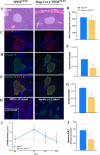Exploring the contribution of mammary-derived serotonin on liver and pancreas metabolism during lactation
- PMID: 38837989
- PMCID: PMC11152252
- DOI: 10.1371/journal.pone.0304910
Exploring the contribution of mammary-derived serotonin on liver and pancreas metabolism during lactation
Abstract
During lactation, the murine mammary gland is responsible for a significant increase in circulating serotonin. However, the role of mammary-derived serotonin in energy homeostasis during lactation is unclear. To investigate this, we utilized C57/BL6J mice with a lactation and mammary-specific deletion of the gene coding for the rate-limiting enzyme in serotonin synthesis (TPH1, Wap-Cre x TPH1FL/FL) to understand the metabolic contributions of mammary-derived serotonin during lactation. Circulating serotonin was reduced by approximately 50% throughout lactation in Wap-Cre x TPH1FL/FL mice compared to wild-type mice (TPH1FL/FL), with mammary gland and liver serotonin content reduced on L21. The Wap-Cre x TPH1FL/FL mice had less serotonin and insulin immunostaining in the pancreatic islets on L21, resulting in reduced circulating insulin but no changes in glucose. The mammary glands of Wap-Cre x TPH1FL/FL mice had larger mammary alveolar areas, with fewer and smaller intra-lobular adipocytes, and increased expression of milk protein genes (e.g., WAP, CSN2, LALBA) compared to TPH1FL/FL mice. No changes in feed intake, body composition, or estimated milk yield were observed between groups. Taken together, mammary-derived serotonin appears to contribute to the pancreas-mammary cross-talk during lactation with potential implications in the regulation of insulin homeostasis.
Copyright: © 2024 Field et al. This is an open access article distributed under the terms of the Creative Commons Attribution License, which permits unrestricted use, distribution, and reproduction in any medium, provided the original author and source are credited.
Conflict of interest statement
The authors have declared that no competing interests exist.
Figures




Similar articles
-
Characterization of mammary-specific disruptions for Tph1 and Lrp5 during murine lactation.Sci Rep. 2017 Nov 9;7(1):15155. doi: 10.1038/s41598-017-15508-0. Sci Rep. 2017. PMID: 29123193 Free PMC article.
-
Serotonin Deficiency Rescues Lactation on Day 1 in Mice Fed a High Fat Diet.PLoS One. 2016 Sep 7;11(9):e0162432. doi: 10.1371/journal.pone.0162432. eCollection 2016. PLoS One. 2016. PMID: 27603698 Free PMC article.
-
Transcriptomic analysis investigating the interaction between peripheral serotonin and high-fat diet feeding on mammary gene expression in midlactation mice.Physiol Genomics. 2020 Jan 1;52(1):47-55. doi: 10.1152/physiolgenomics.00073.2019. Epub 2019 Dec 9. Physiol Genomics. 2020. PMID: 31814535
-
[Endogenous Serotonin and Milk Production Regulation in the Mammary Gland].Yakugaku Zasshi. 2018;138(6):829-836. doi: 10.1248/yakushi.18-00003. Yakugaku Zasshi. 2018. PMID: 29863055 Review. Japanese.
-
TRIENNIAL LACTATION SYMPOSIUM/BOLFA: Serotonin and the regulation of calcium transport in dairy cows.J Anim Sci. 2017 Dec;95(12):5711-5719. doi: 10.2527/jas2017.1673. J Anim Sci. 2017. PMID: 29293773 Free PMC article. Review.
References
MeSH terms
Substances
Grants and funding
LinkOut - more resources
Full Text Sources
Molecular Biology Databases

